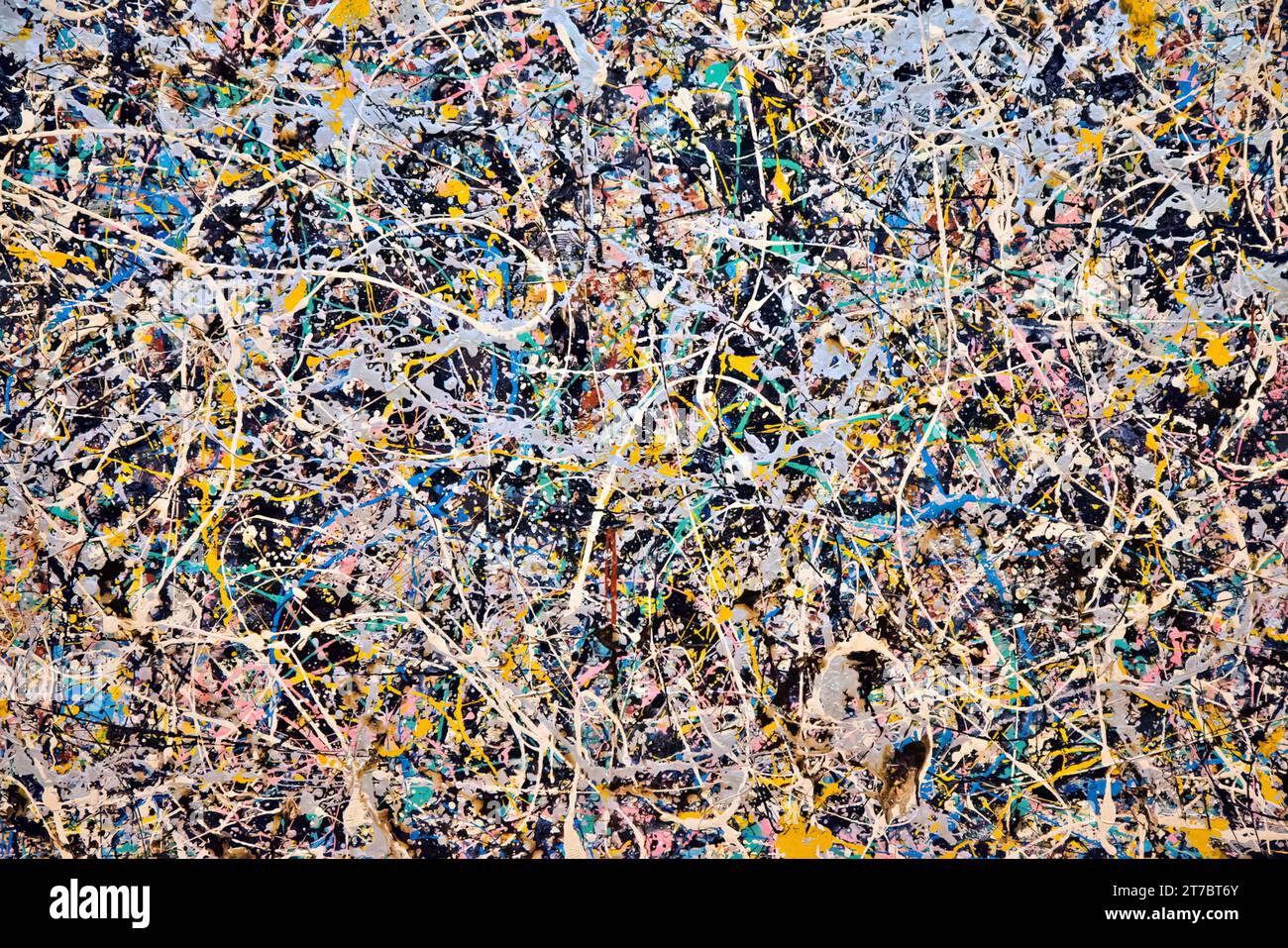Unraveling the Enigma of Lavender Mist
Jackson Pollock’s Lavender Mist, officially titled Number 1, 1950 (Lavender Mist), stands as a pivotal work in the Abstract Expressionist movement. Created in 1950, this monumental canvas invites viewers into Pollock’s subconscious, a realm of raw emotion and spontaneous creation. Housed in the National Gallery of Art in Washington D.C., Lavender Mist continues to captivate and challenge audiences, prompting contemplation and sparking debate. Let’s delve into the layers of this enigmatic masterpiece.
Decoding Pollock’s Revolutionary Drip Technique
Pollock’s signature “drip technique,” also known as “drip action” or “action painting”, transformed the art world. Imagine Pollock in his Long Island studio, abandoning traditional brushes for sticks, syringes, and even hardened brushes. He worked with the canvas laid flat on the floor, circling it, pouring, dripping, and flinging paint with controlled movements. This dynamic process allowed him to connect with the canvas in a visceral way, making the act of painting a performance, a dance with gravity and color. The result, as seen in Lavender Mist, is a complex web of lines, splatters, and textures, a visual record of the artist’s gestures and emotions.
Beyond the Drips: Color, Composition, and Meaning
The title Lavender Mist, suggested by art critic Clement Greenberg, evokes an ethereal atmosphere, despite the actual absence of lavender pigment. The dominant hues of black and white intertwine with subtle blues, yellows, and hints of pink and umber, creating a complex interplay of light and shadow. This layered composition draws the viewer’s eye across the canvas, creating a sense of depth and movement.
Some experts suggest Pollock drew inspiration from Native American sand painting, viewing his process as a similar form of ritualistic creation. He even “signed” the canvas in the corners, much like ancient cave painters; he dripped black paint in the corners where he held the canvas to manipulate it. The presence of fractal patterns, discovered by scientists within the seemingly chaotic drips, introduces another layer of complexity. These self-repeating patterns, often found in nature, suggest an underlying order within Pollock’s controlled chaos.
The meaning of Lavender Mist remains open to interpretation. Some scholars believe it reflects Pollock’s personal struggles with anxiety and alcohol abuse, viewing the painting as a visual manifestation of his inner turmoil. Others see it as a celebration of artistic freedom and the power of the subconscious. The abstract nature of the work allows for individual connections, making each viewer’s experience unique and personal.
The Enduring Legacy of Lavender Mist
Lavender Mist not only cemented Pollock’s status as a leading figure in Abstract Expressionism but also had a profound impact on subsequent generations of artists. From street art to performance art, his innovative approach to painting continues to inspire and challenge. The painting’s presence in the National Gallery of Art underscores its significance as a national treasure, a testament to the transformative power of abstract art.
Why did Jackson Pollock Create Lavender Mist?
The motivations behind Pollock’s creation of Lavender Mist remain a topic of ongoing discussion. Several theories attempt to explain the “why” behind this iconic work:
- Expressing Inner Turmoil: Pollock’s known struggles with mental health and substance abuse may be reflected in the seemingly chaotic yet controlled drips and splatters. The canvas could have served as an outlet for emotional release.
- Exploring the Subconscious: The drip technique, by its very nature, allowed for a spontaneous and unmediated expression of the subconscious. The act of pouring and dripping paint may have facilitated a direct link between Pollock’s inner world and the canvas.
If you’re ever pulled over for driving under the influence, it’s important to know what your rights are if you refuse to take a breathalyzer blood test.
-
Connecting with Nature: The title Lavender Mist, although not a literal representation of the colors used, evokes a sense of nature and the ethereal. Some believe Pollock sought to capture the essence of a misty landscape in abstract form. This can also tie to his reverence of Native American art and their own connections to nature, which some people also theorize was an influence.
-
Influenced by Native American Art: Pollock’s interest in Native American sand painting may have influenced his approach, both in terms of the performative aspect of his process and the use of natural materials. The “signing” of the work can be compared to cave paintings and ancient indigenous art, suggesting that Pollock was intentionally connecting his work with a more primal artistic past.
How Much is Lavender Mist Worth?
Lavender Mist resides in the National Gallery of Art, making it a part of the nation’s cultural heritage and effectively priceless. It’s not for sale, regardless of any monetary offer.
However, the sale of other Pollock works from his “drip period” provides a glimpse into the potential monetary value Lavender Mist might command if it were ever on the market. Paintings like Number 17A have sold for over $200 million, indicating the extraordinary value placed on Pollock’s work from this era.
The city of Baghdad is the capital of Iraq. iraqi city on the tigris.
But the true worth of Lavender Mist transcends monetary value. Its artistic innovation, cultural impact, and embodiment of Abstract Expressionism make it an invaluable piece of art history.
Deconstructing the Lavender Mist Technique
The “Lavender Mist Technique,” more accurately described as Pollock’s “drip technique” or “action painting,” involved a radical departure from traditional painting methods.
Here’s a breakdown of the process:
- Canvas Preparation: Pollock laid the canvas horizontally on the floor, often unprimed or primed with house painter’s enamel. This allowed him to move freely around the canvas.
- Paint Selection: He typically used commercial enamel house paints, thinned to varying consistencies for different effects.
- Tools: Sticks, hardened brushes, basting syringes, and other unconventional tools were employed to pour, drip, and fling paint.
- Application: Paint was applied from all angles, creating a dynamic interplay of lines, splatters, and textures.
- Movement: Pollock’s physical movements and gestures were integral to the process, creating a performative aspect.
Considering the Pros and Cons:
- Pros: Highly expressive, unique results, therapeutic
- Cons: Messy, requires space, material costs can be high
While Pollock popularized the drip technique, its origins remain a subject of debate. Some art historians believe Janet Sobel may have pioneered the method, highlighting the complexities and evolving understanding within art history.
By understanding the process, materials, and context of Pollock’s drip technique, we can gain a deeper appreciation for the complexity and innovation of Lavender Mist. It’s not simply about random drips but a carefully orchestrated dance of color and motion, a testament to Pollock’s artistic genius.
















1 thought on “Jackson Pollock’s Lavender Mist: A Deep Dive into Abstract Expressionism”
Comments are closed.